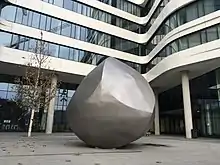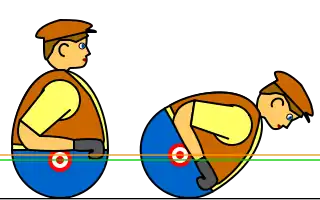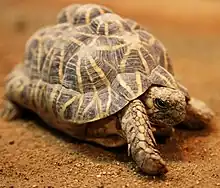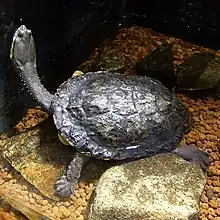Gömböc
The gömböc (Hungarian: [ˈɡømbøt͡s] GUHM-buhts) is the first known physical example of a class of convex three-dimensional homogeneous bodies, called mono-monostatic, which, when resting on a flat surface have just one stable and one unstable point of equilibrium. The existence of this class was conjectured by the Russian mathematician Vladimir Arnold in 1995 and proven in 2006 by the Hungarian scientists Gábor Domokos and Péter Várkonyi by constructing at first a mathematical example and subsequently a physical example. Mono-monostatic shapes exist in countless varieties, most of which are close to a sphere, with a stringent shape tolerance (about one part in a thousand).



The gömböc is the first mono-monostatic shape which has been constructed physically. It has a sharpened top, as shown in the photo. Its shape helped to explain the body structure of some tortoises in relation to their ability to return to an equilibrium position after being placed upside down.[1][2][3] Copies of the gömböc have been donated to institutions and museums, and the largest one was presented at the World Expo 2010 in Shanghai, China.[4]
Name
If analyzed quantitatively in terms of flatness and thickness, the discovered mono-monostatic bodies are the most sphere-like, apart from the sphere itself. Because of this, the first physical example was named gömböc, a diminutive form of gömb ("sphere" in Hungarian).
History

In geometry, a body with a single stable resting position is called monostatic, and the term mono-monostatic has been coined to describe a body which additionally has only one unstable point of balance. (The previously known monostatic polyhedron does not qualify, as it has several unstable equilibria.) A sphere weighted so that its center of mass is shifted from the geometrical center is mono-monostatic. However, it is inhomogeneous; that is, its material density varies across its body. Another example of an inhomogeneous mono-monostatic body is the Comeback Kid, Weeble or roly-poly toy (see left figure). At equilibrium, the center of mass and the contact point are on the line perpendicular to the ground. When the toy is pushed, its center of mass rises and shifts away from that line. This produces a righting moment, which returns the toy to the equilibrium position.
The above examples of mono-monostatic objects are necessarily inhomogeneous. The question of whether it is possible to construct a three-dimensional body which is mono-monostatic but also homogeneous and convex was raised by Russian mathematician Vladimir Arnold in 1995. Being convex is essential as it is trivial to construct a mono-monostatic non-convex body: an example would be a ball with a cavity inside it. It was already well known, from a geometrical and topological generalization of the classical four-vertex theorem, that a plane curve has at least four extrema of curvature, specifically, at least two local maxima and at least two local minima (see right figure), meaning that a (convex) mono-monostatic object does not exist in two dimensions. Whereas a common anticipation was that a three-dimensional body should also have at least four extrema, Arnold conjectured that this number could be smaller.[5]
Mathematical solution


The problem was solved in 2006 by Gábor Domokos and Péter Várkonyi. Domokos met Arnold in 1995 at a major mathematics conference in Hamburg, where Arnold presented a plenary talk illustrating that most geometrical problems have four solutions or extremal points. In a personal discussion, however, Arnold questioned whether four is a requirement for mono-monostatic bodies and encouraged Domokos to seek examples with fewer equilibria.[6]
The rigorous proof of the solution can be found in references of their work.[5] The summary of the results is that the three-dimensional homogeneous convex (mono-monostatic) body, which has one stable and one unstable equilibrium point, does exist and is not unique. Such bodies are hard to visualize, describe or identify. Their form is dissimilar to any typical representative of any other equilibrium geometrical class. They should have minimal "flatness" and, to avoid having two unstable equilibria, must also have minimal "thinness". They are the only non-degenerate objects having simultaneously minimal flatness and thinness. The shape of those bodies is susceptible to small variation, outside which it is no longer mono-monostatic. For example, the first solution of Domokos and Várkonyi closely resembled a sphere, with a shape deviation of only 10−5. It was dismissed as it was tough to test experimentally.[7] The gömböc, as the first physical example, is less sensitive; yet it has a shape tolerance of 10−3, that is 0.1 mm for a 10 cm size.
Domokos developed a classification system for shapes based on their points of equilibrium by analyzing pebbles and noting their equilibrium points.[8] In one experiment, Domokos and his wife tested 2000 pebbles collected on the beaches of the Greek island of Rhodes and found not a single mono-monostatic body among them, illustrating the difficulty of finding or constructing such a body.[5][7]
The solution of Domokos and Várkonyi has curved edges and resembles a sphere with a squashed top. In the top figure, it rests in its stable equilibrium. Its unstable equilibrium position is obtained by rotating the figure 180° about a horizontal axis. Theoretically, it will rest there, but the smallest perturbation will bring it back to the stable point. All mono-monostatic shapes (including the gömböc shape) have sphere-like properties. In particular, its flatness and thinness are minimal, and this is the only type of nondegenerate object with this property.[5] Domokos and Várkonyi are interested in finding a polyhedral solution with a surface consisting of a minimal number of flat planes. There is a prize[3] to anyone who finds the respective minimal numbers of F, E, and V faces, edges and vertices for such a polyhedron, which amounts to $10,000 divided by the number C = F + E + V − 2, which is called the mechanical complexity of mono-monostatic polyhedra. It has been proved that one can approximate a curvilinear mono-monostatic shape with a finite number of discrete surfaces;[9] however, they estimate that it would take thousands of planes to achieve that. By offering this prize, they hope to stimulate finding a radically different solution from their own.[3]
Relation to animals


The balancing properties of the gömböc are associated with the "righting response" — the ability to turn back when placed upside down — of shelled animals such as tortoises and beetles. These animals may become flipped over in a fight or predator attack, and so the righting response is crucial for survival. In order to right themselves, relatively flat animals (such as beetles) heavily rely on momentum and thrust developed by moving their limbs and wings. However, the limbs of many dome-shaped tortoises are too short to be of use in for righting.
Domokos and Várkonyi spent a year measuring tortoises in the Budapest Zoo, Hungarian Museum of Natural History and various pet shops in Budapest, digitizing and analyzing their shells, and attempting to "explain" their body shapes and functions from their geometry work published by the biology journal Proceedings of the Royal Society.[10] It was then immediately popularized in several science news reports, including the science journals Nature[2] and Science.[3] The reported model can be summarized as flat shells in tortoises are advantageous for swimming and digging. However, the sharp shell edges hinder the rolling. Those tortoises usually have long legs and necks and actively use them to push the ground to return to the normal position if placed upside down. On the contrary, "rounder" tortoises easily roll on their own; those have shorter limbs and use them little when recovering from lost balance. (Some limb movement would always be needed because of imperfect shell shape, ground conditions, etc.) Round shells also resist better the crushing jaws of a predator and are better for thermal regulation.[1][2][3]
Art
In the fall of 2020, the Korzo Theatre in The Hague and the Theatre Municipal in Biarritz presented the solo dance production "Gömböc" [11] by French choreographer Antonin Comestaz.[12]
A 2021 solo exhibition of conceptual artist Ryan Gander evolved around the theme of self-righting and featured seven large gömböc shapes gradually covered by black volcanic sand.[13]
Media
For their discovery, Domokos and Várkonyi were decorated with the Knight's Cross of the Republic of Hungary.[14] The New York Times Magazine selected the gömböc as one of the 70 most interesting ideas of the year 2007.[15]
The Stamp News website[16] shows Hungary's new stamps issued on 30 April 2010, which illustrate a gömböc in different positions. The stamp booklets are arranged so that the gömböc appears to come to life when the booklet is flipped. The stamps were issued in association with the gömböc on display at the World Expo 2010 (1 May to 31 October). This was also covered by the Linn's Stamp News magazine.[17]
References
- Summers, Adam (March 2009). "The Living Gömböc. Some tortoise shells evolved the ideal shape for staying upright". Natural History. 118 (2): 22–23.
- Ball, Philip (16 October 2007). "How tortoises turn right-side up". Nature News. doi:10.1038/news.2007.170. S2CID 178518465.
- Rehmeyer, Julie (5 April 2007). "Can't Knock It Down". Science News.
- Hungary Pavilion features Gomboc, expo.shanghaidaily.com (12 July 2010)
- Varkonyi, P.L.; Domokos, G. (2006). "Mono-monostatic bodies: the answer to Arnold's question" (PDF). The Mathematical Intelligencer. 28 (4): 34–38. doi:10.1007/bf02984701. S2CID 15720880.
- Domokos, Gábor (2008). "My Lunch with Arnold" (PDF). The Mathematical Intelligencer. 28 (4): 31–33. doi:10.1007/BF02984700. S2CID 120684940.
- Freiberger, Marianne (May 2009). "The Story of the Gömböc". Plus magazine.
- Varkonyi, P.L.; Domokos, G. (2006). "Static Equilibria of Rigid Bodies: Dice, Pebbles, and the Poincare-Hopf Theorem". Journal of Nonlinear Science. 16 (3): 255. Bibcode:2006JNS....16..255V. doi:10.1007/s00332-005-0691-8. S2CID 17412564.
- Lángi, Zsolt (2022). "A solution to some problems of Conway and Guy on monostable polyhedra" (PDF). Bulletin of the London Mathematical Society. 54 (2): 501–516. doi:10.1112/blms.12579. S2CID 220968924.
- Domokos, G.; Varkonyi, P.L. (2008). "Geometry and self-righting of turtles" (free download pdf). Proc. R. Soc. B. 275 (1630): 11–17. doi:10.1098/rspb.2007.1188. PMC 2562404. PMID 17939984.
- "" Gömböc " d'Antonin Comestaz". dansercanalhistorique. 22 September 2020.
- "Categorie:Choreografie Antonin Comestaz". TheaterEncyclopedie. 30 January 2018.
- "Exhibition | Ryan Gander, 'The Self Righting of All Things' at Lisson Gallery, Lisson Street, London, United Kingdom". ocula.com. 14 November 2021.
- A gömböc for the Whipple. News, University of Cambridge (27 April 2009)
- Per-Lee, Myra (9 December 2007) Whose Bright Idea Was That? The New York Times Magazine Ideas of 2007 Archived 11 March 2021 at the Wayback Machine. Inventorspot.com.
- Better City – Better Life: Shanghai World Expo 2010 Archived 16 August 2017 at the Wayback Machine. Stampnews.com (22 November 2010). Retrieved on 20 October 2016.
- McCarty, Denise (28 June 2010) "World of New Issues: Expo stamps picture Hungary's gömböc, Iceland's ice cube". Linn's Stamp News p. 14